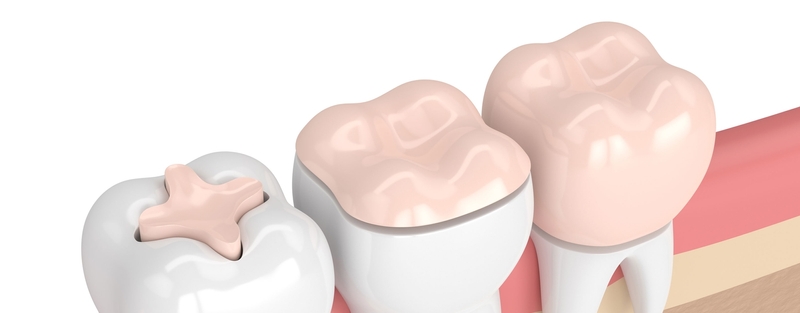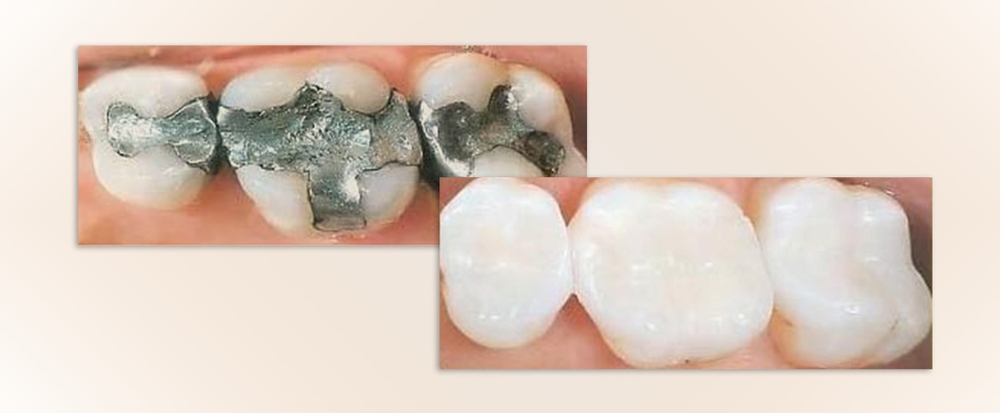Fillings & Crowns
SF Dental offers the full range of modern restorative dental treatments, including tooth-colored fillings and crowns.
About the author, Dr. Stella Kim
The materials on this page were prepared and medically reviewed by Dr. Stella Kim, DDS, a San Francisco dentist and a graduate of the UCSF School of Dentistry.
At SF Dental, we choose restorations that maximize utility, durability, and appearance. Relying on the latest in dental science, we select materials that will give you the healthiest, longest-lasting smile possible.
Tooth-colored composite fillings
Unattractive metal fillings are a thing of the past. Natural-looking fillings come standard at SF Dental—they look great, and they’re strong and durable.
These restorations look and feel just like your natural teeth. Proven and effective, non-metal restorations have a long list of benefits over traditional fillings:
- Good resistance to wear
- Conserve and strengthen tooth structure because the material bonds well to enamel
- Beautiful, natural appearance
- Easily maintained with brushing and flossing
Common dental treatments that utilize composite fillings include:
- Filling and building up tooth structure to restore function after removing decay (caries) on the teeth
- Fixing small cracks or chips in teeth caused by injury or wear
- Closing gaps between the teeth
Dental crowns
A crown is a type of dental restoration that covers the entire surface of a tooth. Crowns are generally used when the structure of the existing tooth makes a filling impractical, or if the location of the decay on the tooth would make a filling more likely to fail. Crowns are very durable and long lasting, and they often feel exactly like natural teeth.
Crowns come in many forms, but the most common material is a specialized ceramic. We carefully match the size, shape, and color of the crown to match your existing teeth. The end result is that most people will never be able to tell that the crown isn’t a natural tooth.
Common uses of dental crowns include:
- Restoring a tooth following a root canal
- Repairing large cavities (caries) that are poor candidates for composite fillings
- Following injuries to the tooth caused by excessive wear or traumatic impact
- Treating cracked tooth syndrome (often a cause of bite and temperature sensitivity)
The crown placement process typically requires two appointments:
- On the first appointment, we’ll take a mold (impression) of your existing tooth, numb the tooth, and remove any decay or other problematic areas. We then use your mold to create a temporary crown, right here in the office. The temporary crown is placed on your tooth the same day. It helps to protect the remaining tooth structure and allows you to chew and eat properly while your permanent crown is being made by a specialized lab.
- Approximately two weeks later, you’ll return to finish the procedure. We’ll remove the temporary crown, clean the tooth, and install the permanent crown, carefully adjusting its placement to make sure the spacing is accurate and your bite feels comfortable.
Managing sensitivity following a restoration
During the procedure itself you shouldn’t feel any pain, since the area around the tooth will be numbed. After the numbing wears off, you may feel some unusual sensations, including:
- Tender gums
- Pain in the affected tooth, or in the teeth surrounding it
- Sensitivity to cold and hot (whether food, beverages, or air temperature)
- Sensitivity to chewing, clenching, brushing, or flossing
In the vast majority of cases, these symptoms are mild and go away within a couple of weeks. Some steps you can take to manage sensitivity include:
- Take over-the-counter pain medication, such as ibuprofen (Advil)
- If possible, avoid chewing with the affected teeth
- Use a desensitizing toothpaste
- Consume food and drinks at lukewarm temperatures
- Avoid acidic foods and beverages like soda, fruit juice, and yogurt
Issues to watch out for following a restoration
Dental restorations are routine procedures that rarely lead to any serious complications. That said, there are a few things that you should keep an eye out for after your procedure. If you experience any of these, contact us as soon as possible.
- Pulpitis or pulp necrosis: If your gums become very swollen or pockets of pus start forming, you may have an infection in the pulp. This is a rare condition that sometimes occurs after decayed tooth tissue is removed. Further treatment, such as a root canal, will be required to stop the infection and alleviate the pain.
- Bite irregularities: If your new filling or crown seems to stick out too much or push against other teeth, it may need to be adjusted. You might be tempted to think this is a minor issue and you can just “get used to it.” In fact, the opposite is true! These small bite irregularities can cause additional dental injury, sometimes leading to cracks in other teeth or jaw problems. Your restoration should feel natural and normal. If it doesn’t, it’s best to have us adjust it for you.
- Ongoing sensitivity: In most cases, sensitivity resolves within a few weeks of treatment, but if you continue to have ongoing, debilitating sensitivity, there may be some other underlying issue that needs to be addressed.
Further reading
- American Dental Association. (2003). Sensitive teeth.
- Carr A. (2014). “Adult health: What causes sensitive teeth, and how can I treat them?” Mayo Clinic.
- Cleveland Clinic. (2013). More on fillings.
- Pozzi A, et al. (2011). “Pain management for dentists: The role of ibuprofen.” Annali di stomatologia.
- Ubertalli JT. (2016). Pulpitis. Merck Manual.



